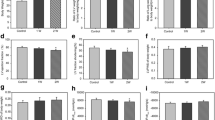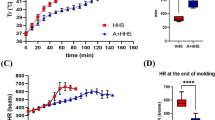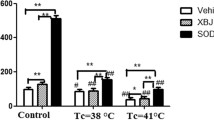Abstract
Exposure to humid heat stress leads to the initiation of serious physiological dysfunction that may result in heat-related diseases, including heat stroke, heat cramp, heat exhaustion, and even death. Increasing evidences have shown that the humid heat stress-induced dysfunction of the cardiovascular system was accompanied with severe cardiomyocyte injury; however, the precise mechanism of heat stress-induced injury of cardiomyocyte remains unknown. In the present study, we hypothesized that humid heat stress promoted oxidative stress through the activation of angiotensin II (Ang II) in cardiomyocytes. To test our hypothesis, we established mouse models of humid heat stress. Using the animal models, we found that Ang II levels in serum were significantly up-regulated and that the Ang II receptor AT1 was increased in cardiomyocytes. The antioxidant ability in plasma and heart tissues which was detected by the ferric reducing/antioxidant power assay was also decreased with the increased ROS production under humid heat stress, as was the expression of antioxidant genes (SOD2, HO-1, GPx). Furthermore, we demonstrated that the Ang II receptor antagonist, valsartan, effectively relieved oxidative stress, blocked Ang II signaling pathway and suppressed cardiomyocyte apoptosis induced by humid heat stress. In addition, overexpression of antioxidant genes reversed cardiomyocyte apoptosis induced by Ang II. Overall, these results implied that humid heat stress increased oxidative stress and caused apoptosis of cardiomyocytes through the Ang II signaling pathway. Thus, targeting the Ang II signaling pathway may provide a promising approach for the prevention and treatment of cardiovascular diseases caused by humid heat stress.










Similar content being viewed by others
Abbreviations
- Ang II:
-
Angiotensin II
- AOA:
-
Antioxidant ability
- AT1:
-
Angiotensin receptor 1
- ELISA:
-
Enzyme linked immunosorbent assay
- FRAP:
-
The ferric reducing/antioxidant power assay
- GPx:
-
Glutathione peroxidase
- HHS:
-
Humid heat stress
- HO-1:
-
Heme oxygenase 1
- HRP:
-
Horseradish peroxidase
- JNK:
-
c-Jun amino-terminal kinases
- LDH:
-
Lactate dehydrogenase
- MAPKs:
-
Mitogen-activated protein kinases
- MDA:
-
Malondialdehyde
- NAD(P)H:
-
Nicotinamide-adenine dinucleotide phosphate
- qRT-PCR:
-
Quantitative real-time polymerase chain reaction
- RAS:
-
Renin–angiotensin system
- ROS:
-
Reactive oxygen species
- RT:
-
Room temperature
- SOD:
-
Superoxide dismutase
- TBS:
-
Tris-buffered saline
- TBST:
-
TBS and tween
- TPTZ:
-
Tripyridyl-s-triazine
References
Bouchama A, Knochel JP (2002) Heat stroke. N Engl J Med 346:1978–1988
Shaver JF (1982) The basic mechanisms of fever: considerations for therapy. Nurse Pract 7:15–19
Qian L, Song X, Ren H, Gong J, Cheng S (2004) Mitochondrial mechanism of heat stress-induced injury in rat cardiomyocyte. Cell Stress Chaperones 9:281–293
Hall DM, Buettner GR, Oberley LW, Xu L, Matthes RD, Gisolfi CV (2001) Mechanisms of circulatory and intestinal barrier dysfunction during whole body hyperthermia. Am J Physiol Heart Circ Physiol 280:H509–H521
Hall DM, Baumgardner KR, Oberley TD, Gisolfi CV (1999) Splanchnic tissues undergo hypoxic stress during whole body hyperthermia. Am J Physiol 276:G1195–G1203
Fehrenbach E, Niess AM, Schlotz E (2000) Transcriptional and translational regulation of heat shock proteins in leukocytes of endurance runners. J Appl Physiol 89:704–710
Steenland K (1996) Epidemiology of occupation and coronary heart disease: research agenda. Am J Ind Med 30:495–499
Chien KR (2000) Genomic circuits and the integrative biology of cardiac diseases. Nature 407:227–232
Qian LJ, Cheng SQ, Wu MP (1999) Changes of mitochondrial function in heat stressed rats. Chin J Pathol Physiol 15:333–335
Song XL, Qian LJ, Li FZ (2000) Injury of heat stress on rat cardiomyocytes. Chin J Appl Physiol 16:227–230
Fujita S, Shimojo N, Terasaki F, Otsuka K, Hosotani N, Kohda Y, Tanaka T, Nishioka T, Yoshida T, Hiroe M, Kitaura Y, Ishizaka N, Imanaka-Yoshida K (2013) Atrial natriuretic peptide exerts protective action against angiotensin II-induced cardiac remodeling by attenuating inflammation via endothelin-1/endothelin receptor A cascade. Heart Vessels 28:646–657
Hall JE (1986) Control of sodium excretion by angiotensin II: intrarenal mechanisms and blood pressure regulation. Am J Physiol 250:R960–R972
Hall JE, Granger JP (1986) Adenosine alters glomerular filtration control by angiotensin II. Am J Physiol 250:F917–F923
Paradis P, Dali-Youcef N, Paradis FW, Thibault G, Nemer M (2000) Overexpression of angiotensin II type I receptor in cardiomyocytes induces cardiac hypertrophy and remodeling. Proc Natl Acad Sci USA 97:931–936
Abe M, Suzuki H, Okada K, Maruyama N, Inoshita A, Baba S, Takashima H, Soma M (2013) Efficacy analysis of the renoprotective effects of aliskiren in hypertensive patients with chronic kidney disease. Heart Vessels 28:442–452
Hitomi H, Kiyomoto H, Nishiyama A (2007) Angiotensin II and oxidative stress. Curr Opin Cardiol 22:311–315
Salmeen A, Barford D (2005) Functions and mechanisms of redox regulation of cysteine-based phosphatases. Antioxid Redox Signal 7:560–577
Ushio-Fukai M, Alexander RW, Akers M, Griendling KK (1998) p38 Mitogen-activated protein kinase is a critical component of the redox-sensitive signaling pathways activated by angiotensin II. Role in vascular smooth muscle cell hypertrophy. J Biol Chem 273:15022–15029
Kyaw M, Yoshizumi M, Tsuchiya K, Kirima K, Tamaki T (2001) Antioxidants inhibit JNK and p38 MAPK activation but not ERK 1/2 activation by angiotensin II in rat aortic smooth muscle cells. Hypertens Res 24:251–261
Hogaboam CM, Vallance BA, Kumar A, Addison CL, Graham FL, Gauldie J, Collins SM (1997) Therapeutic effects of interleukin-4 gene transfer in experimental inflammatory bowel disease. J Clin Invest 100:2766–2776
Xing Z, Ohkawara Y, Jordana M, Graham F, Gauldie J (1996) Transfer of granulocyte-macrophage colony-stimulating factor gene to rat lung induces eosinophilia, monocytosis, and fibrotic reactions. J Clin Invest 97:1102–1110
Das A, Xi L, Kukreja RC (2005) Phosphodiesterase-5 inhibitor sildenafil preconditions adult cardiac myocytes against necrosis and apoptosis. Essential role of nitric oxide signaling. J Biol Chem 280:12944–12955
Xi L, Hess ML, Kukreja RC (1998) Ischemic preconditioning in isolated perfused mouse heart: reduction in infarct size without improvement of post-ischemic ventricular function. Mol Cell Biochem 186:69–77
De Angelis N, Fiordaliso F, Latini R, Calvillo L, Funicello M, Gobbi M, Mennini T, Masson S (2002) Appraisal of the role of angiotensin II and aldosterone in ventricular myocyte apoptosis in adult normotensive rat. J Mol Cell Cardiol 34:1655–1665
Livak KJ, Schmittgen TD (2001) Analysis of relative gene expression data using real-time quantitative PCR and the 2(−Delta Delta C(T)) method. Methods 25:402–408
Havenith G, Luttikholt VG, Vrijkotte TG (1995) The relative influence of body characteristics on humid heat stress response. Eur J Appl Physiol Occup Physiol 70:270–279
Qin M, Rao ZR, Wang JJ, Zhao BM, Yang Q, Wang XX, Huang YX (2007) Influence of intrathecal injection of fluorocitrate on the protective effect of electroacupuncture on gastric mucosa in high humid heat stress rats. Zhen Ci Yan Jiu 32:158–162
Sealey JE, Alderman MH, Furberg CD, Laragh JH (2013) Renin–angiotensin system blockers may create more risk than reward for sodium-depleted cardiovascular patients with high plasma renin levels. Am J Hypertens 26:727–738
Ellis KL, Palmer BR, Frampton CM, Troughton RW, Doughty RN, Whalley GA, Ellis CJ, Pilbrow AP, Skelton L, Yandle TG, Richards AM, Cameron VA (2013) Genetic variation in the renin–angiotensin–aldosterone system is associated with cardiovascular risk factors and early mortality in established coronary heart disease. J Hum Hypertens 27:237–244
Palomeque J, Sapia L, Hajjar RJ, Mattiazzi A, Vila Petroff M (2006) Angiotensin II-induced negative inotropy in rat ventricular myocytes: role of reactive oxygen species and p38 MAPK. Am J Physiol Heart Circ Physiol 290:H96–H106
Ichiyanagi O, Ishii K, Endoh M (2002) Angiotensin II increases L-type Ca2+ current in gramicidin D-perforated adult rabbit ventricular myocytes: comparison with conventional patch-clamp method. Pflugers Arch 444:107–116
Pradhan N, Rossi NF (2013) Interactions between the sympathetic nervous system and angiotensin system in renovascular hypertension. Curr Hypertens Rev 9:121–129
Low DA, Keller DM, Wingo JE, Brothers RM, Crandall CG (2011) Sympathetic nerve activity and whole body heat stress in humans. J Appl Physiol (1985) 111:1329–1334
Cui J, Shibasaki M, Low DA, Keller DM, Davis SL, Crandall CG (2011) Muscle sympathetic responses during orthostasis in heat-stressed individuals. Clin Auton Res 21:381–387
San Martin A, Du P, Dikalova A, Lassegue B, Aleman M, Gongora MC, Brown K, Joseph G, Harrison DG, Taylor WR, Jo H, Griendling KK (2007) Reactive oxygen species-selective regulation of aortic inflammatory gene expression in Type 2 diabetes. Am J Physiol Heart Circ Physiol 292:H2073–H2082
Lassegue B, Griendling KK (2004) Reactive oxygen species in hypertension. Am J Hypertens 17:852–860
Nordberg J, Arner ES (2001) Reactive oxygen species, antioxidants, and the mammalian thioredoxin system. Free Radic Biol Med 31:1287–1312
Halliwell B, Cross CE (1994) Oxygen-derived species: their relation to human disease and environmental stress. Environ Health Perspect 102:5–12
Davies KJ (1995) Oxidative stress: the paradox of aerobic life. Biochem Soc Symp 61:1–31
Pagano PJ, Ito Y, Tornheim K, Gallop PM, Tauber AI, Cohen RA (1995) An NADPH oxidase superoxide-generating system in the rabbit aorta. Am J Physiol 268:H2274–H2280
Kimura S, Zhang GX, Nishiyama A, Shokoji T, Yao L, Fan YY, Rahman M, Suzuki T, Maeta H, Abe Y (2005) Role of NAD(P)H oxidase- and mitochondria-derived reactive oxygen species in cardioprotection of ischemic reperfusion injury by angiotensin II. Hypertension 45:860–866
Spurlock ME, Savage JE (1993) Effect of dietary protein and selected antioxidants on fatty liver hemorrhagic syndrome induced in Japanese quail. Poult Sci 72:2095–2105
Enkvetchakul B, Bottje W, Anthony N, Moore R, Huff W (1993) Compromised antioxidant status associated with ascites in broilers. Poult Sci 72:2272–2280
Kang YJ, Chen Y, Epstein PN (1996) Suppression of doxorubicin cardiotoxicity by overexpression of catalase in the heart of transgenic mice. J Biol Chem 271:12610–12616
Das J, Ghosh J, Manna P, Sil PC (2011) Taurine suppresses doxorubicin-triggered oxidative stress and cardiac apoptosis in rat via up-regulation of PI3-K/Akt and inhibition of p53, p38-JNK. Biochem Pharmacol 81:891–909
Tone E, Kunisada K, Fujio Y, Matsui H, Negoro S, Oh H, Kishimoto T, Yamauchi-Takihara K (1998) Angiotensin II interferes with leukemia inhibitory factor-induced STAT3 activation in cardiac myocytes. Biochem Biophys Res Commun 253:147–150
Li HL, Suzuki J, Bayna E, Zhang FM, Dalle Molle E, Clark A, Engler RL, Lew WY (2002) Lipopolysaccharide induces apoptosis in adult rat ventricular myocytes via cardiac AT(1) receptors. Am J Physiol Heart Circ Physiol 283:H461–H467
Ding B, Abe J, Wei H, Huang Q, Walsh RA, Molina CA, Zhao A, Sadoshima J, Blaxall BC, Berk BC, Yan C (2005) Functional role of phosphodiesterase 3 in cardiomyocyte apoptosis: implication in heart failure. Circulation 111:2469–2476
Kajstura J, Cigola E, Malhotra A, Li P, Cheng W, Meggs LG, Anversa P (1997) Angiotensin II induces apoptosis of adult ventricular myocytes in vitro. J Mol Cell Cardiol 29:859–870
Author information
Authors and Affiliations
Corresponding author
Rights and permissions
About this article
Cite this article
Wang, X., Yuan, B., Dong, W. et al. Humid heat exposure induced oxidative stress and apoptosis in cardiomyocytes through the angiotensin II signaling pathway. Heart Vessels 30, 396–405 (2015). https://doi.org/10.1007/s00380-014-0523-6
Received:
Accepted:
Published:
Issue Date:
DOI: https://doi.org/10.1007/s00380-014-0523-6




